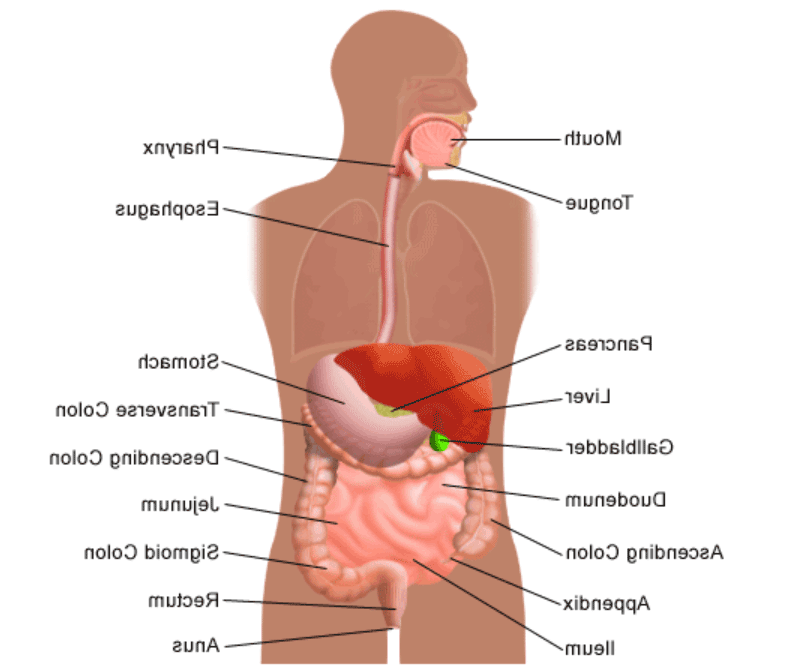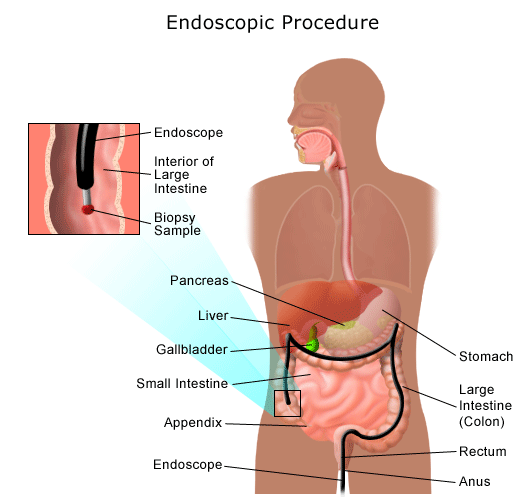Gas in the Digestive Tract
What is gas in the digestive tract?
Gas in the digestive tract is created from:
-
Swallowing air
-
结肠中的细菌对某些食物的分解

Everyone has gas. 它可能会让人感到不舒服和尴尬,但它不会危及生命. 气体通过打嗝或通过直肠排出. 大多数人每天产生大约1到4品脱的气体,每天排出大约14次气体.
Most gas is made up of odorless vapors--carbon dioxide, oxygen, nitrogen, hydrogen, and sometimes methane. 大肠中的细菌释放出含有硫的气体,并产生令人不快的胀气气味.
What causes gas in the digestive tract?
Gas in the digestive tract comes from two sources:
-
Aerophagia (air swallowing). This is usually caused by eating or drinking rapidly, chewing gum, smoking, or wearing loose dentures.
Belching is the way most swallowed air leaves the stomach. 剩余的气体部分被小肠吸收,少量进入大肠,并通过直肠释放.
-
大肠(结肠)中天然存在的无害细菌分解某些未消化的食物
Some carbohydrates (sugar, starches, 和纤维)在小肠中不能被消化或吸收因为某些酶的缺乏. 未消化或未吸收的食物随后进入大肠, where harmless and normal bacteria break down the food. This process produces hydrogen, carbon dioxide, and, in about one-third of all people, methane gases, which are released through the rectum.
| Foods that commonly cause gas |
|---|
根据国家糖尿病、消化和肾脏疾病研究所, most foods that contain carbohydrates can cause gas, however, fats and proteins cause little gas. Foods that cause gas include the following:
|
What are the symptoms of gas?
由过多气体或严重疾病引起的慢性症状是罕见的. The following are the most common symptoms of gas. 然而,每个人可能经历不同的症状. Symptoms may include:
-
Belching. Belching during or after meals is normal, 但经常打嗝的人可能是吞咽了太多的空气,在空气进入胃之前就释放了.
慢性打嗝也可能表明上消化道疾病,如 peptic ulcer disease, gastroesophageal reflux disease (GERD), or gastritis.
根据NIDDK,与打嗝相关的罕见的慢性气体综合征包括:
-
Meganblase syndrome. Meganblase syndrome causes chronic belching. 它的特点是严重的空气吞咽和胃中大量的气体泡. 这种疾病引起的充盈和呼吸短促可能类似于心脏病发作.
-
Gas-bloat syndrome. Gas-bloat syndrome may occur after surgery to correct GERD. 该手术在食道和胃之间制造了一个单向阀,允许食物和气体进入胃.
-
-
Flatulence. Passing gas through the rectum is called flatulence. Passing gas 14 to 23 times a day is considered normal.
-
Abdominal bloating. 腹胀通常是肠道运动障碍的结果,例如 irritable bowel syndrome (IBS). 运动障碍的特征是肠道肌肉的异常运动和收缩. 由于对气体的敏感性增加,这些疾病可能会给人一种腹胀的错觉.
-
脾弯曲综合征是一种慢性疾病,可能是由结肠弯曲处的气体引起的.
-
Crohn's disease, colon cancer或任何引起肠梗阻的疾病,也可能引起腹胀.
-
手术引起的内部疝或粘连(疤痕组织)可能引起腹胀或疼痛.
-
高脂肪食物会延迟胃排空,导致腹胀和不适, but not necessarily too much gas.
-
-
Abdominal pain and discomfort. Gas in the intestine causes pain for some people. 当它聚集在结肠左侧时,疼痛可能与心脏病混淆. When it collects on the right side of the colon, 这种疼痛感觉可能与胆结石或阑尾炎有关.
气体的症状可能类似于其他医疗状况或问题. Always consult your doctor for a diagnosis.
How is gas in the digestive tract diagnosed?
气的症状可能是由严重的疾病引起的,应该确定. 除了完整的病史和体格检查, 你的医生可能会建议以下活动来协助诊断:
-
Food diary. 你可能会被要求记录一段时间内所吃的食物和饮料, 和/或计算你一天中放屁的次数.
-
Colonoscopy. For people 50 years of age and older, and for those with a family history, the possibility of colorectal cancer is considered. 结肠镜检查可以让医生看到大肠的整个长度, and can often help identify abnormal growths, inflamed tissue, ulcers, and bleeding. It involves inserting a colonoscope, a long, flexible, lighted tube, in through the rectum up into the colon. 结肠镜可以让医生看到结肠的内壁, remove tissue for further examination, and possibly treat some problems that are discovered.
-
Sigmoidoscopy. 乙状结肠镜检查是一种诊断程序,允许医生检查大肠的一部分内部, and is helpful in identifying the causes of diarrhea, abdominal pain, constipation, abnormal growths, and bleeding. A short, flexible, lighted tube, called a sigmoidoscope, is inserted into the intestine through the rectum. 瞄准镜将空气吹入肠道,使其膨胀,使观察内部更容易.
-
Upper GI (gastrointestinal) series (also called barium swallow). For chronic belching, 你的医生会寻找吞咽空气过多的迹象或原因,并可能要求进行上消化道系列检查. 上消化道系列检查是一种诊断性检查,检查消化系统上部的器官:食道, stomach, and duodenum (the first section of the small intestine). A fluid called barium (a metallic, chemical, chalky, (用来包裹器官内部的液体,以便在x光片上显示出来)被吞下. X-rays are then taken to evaluate the digestive organs.
Treatment for gas in the digestive tract
针对消化道气体的具体治疗方法将由您的医生根据以下情况确定:
-
Your age, overall health, and medical history
-
Extent of the condition
-
你对特定药物、程序或疗法的耐受性
-
Expectations for the course of the condition
-
Your opinion or preference
Preventing gas in the digestive tract
最常见的减少气体不适的方法包括:
-
Changes in the diet
-
Medications
-
Reducing the amount of air swallowed







